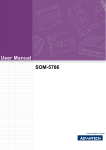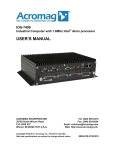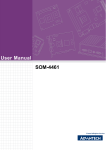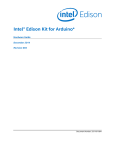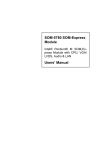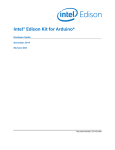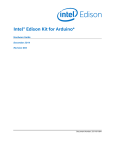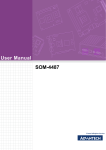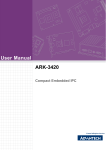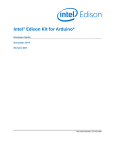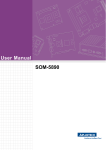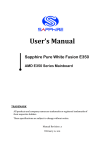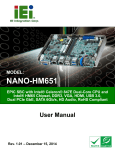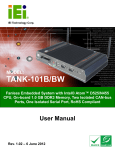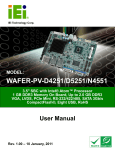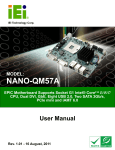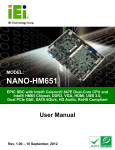Download User Manual SOM-6760
Transcript
User Manual SOM-6760 Copyright This document is copyrighted, © 2008. All rights are reserved. The original manufacturer reserves the right to make improvements to the products described in this manual at any time without notice. No part of this manual may be reproduced, copied, translated or transmitted in any form or by any means without the prior written permission of the original manufacturer. Information provided in this manual is intended to be accurate and reliable. However, the original manufacturer assumes no responsibility for its use, nor for any infringements upon the rights of third parties that may result from such use. Trademarks Award is a trademark of Award Software International, Inc. VIA is a trademark of VIA Technologies, Inc. IBM, PC/AT, PS/2 and VGA are trademarks of International Business Machines Corporation. Intel and Pentium are trademarks of Intel Corporation. Microsoft Windows® is a registered trademark of Microsoft Corp. RTL is a trademark of Realtek Semi-Conductor Co., Ltd. ESS is a trademark of ESS Technology, Inc. UMC is a trademark of United Microelectronics Corporation. SMI is a trademark of Silicon Motion, Inc. Creative is a trademark of Creative Technology LTD. CHRONTEL is a trademark of Chrontel Inc. All other product names or trademarks are properties of their respective owners. SOM-6760 User Manual Part No. 2006676000 Edition 1 Printed in Taiwan March 2009 ii Product Warranty (2 years) Warranty Period ADVANTECH aims to meet the customer’s expectations for post-sales service and support; therefore, in addition to offering 2 years global warranty for ADVANTECH’s standard products, a global extended warranty service is also provided for customers upon request. ADVANTECH customers are entitled to a complete and prompt repair service beyond the standard 2 years of warranty. Standard products manufactured by ADVANTECH are covered by a 2 year global warranty from the date of shipment. Products covered by extended warranty and cross-region repair services against defects in design, materials, and workmanship, are also covered from the date of shipment. All key parts assembled into ADVANTECH system products such as LCD, Touch Screen, Power Supply, and peripherals etc, will be also covered by the standard 2 year warranty. Repairs under Warranty It is possible to obtain a replacement (Cross-Shipment) during the first 30 days of purchase (45 days for Channel Partners), if the products were purchased directly from ADVANTECH and the product is DOA (Dead-on-Arrival). DOA Cross-Shipment excludes any customized and/or build-to-order products. The Cross-Shipment agreement signed by customers is required for initiating/releasing cross shipment with ADVANTECH confirmation and verification. The only conditions for Cross-Shipment are: a) the return must not be damaged, altered or marked, b) all parts and accessories must be included as originally shipped; and c) proof of purchase must be included. Any returns that do not meet mentioned requirements above, or any wrong user settings/configurations will be denied, or subject to additional handling/service charges as determined by the ADVANTECH Repair Service Department. For those products which are not DOA, the return fee to an authorized ADVANTECH repair facility will be at the customers’ expense. The shipping fee for reconstructive products from ADVANTECH back to customers’ sites will be at ADVANTECH°Øs expense. Exclusions from Warranty The product is excluded from warranty if: The product has been found to be defective after expiry of the warranty period. Warranty has been voided by removal or alternation of product or part identification labels. The product has been misused, abused, or subjected to unauthorized disassembly/modification; placed in an unsuitable physical or operating environment; improperly maintained by the customer; or failure caused which ADVANTECH is not responsible whether by accident or other cause. Such conditions will be determined by ADVANTECH at its sole unfettered discretion. The product is damaged beyond repair due to a natural disaster such as a lighting strike, flood, earthquake, etc. Product updates/upgrades and tests upon the request of customers who are without warranty. iii SOM-6760 User Manual Declaration of Conformity FCC This device complies with the requirements in part 15 of the FCC rules: Operation is subject to the following two conditions: 1. This device may not cause harmful interference, and 2. This device must accept any interference received, including interference that may cause undesired operation. This equipment has been tested and found to comply with the limits for a Class A digital device, pursuant to Part 15 of the FCC Rules. These limits are designed to provide reasonable protection against harmful interference when the equipment is operated in a commercial environment. This equipment generates, uses, and can radiate radio frequency energy and, if not installed and used in accordance with the instruction manual, may cause harmful interference to radio communications. Operation of this device in a residential area is likely to cause harmful interference in which case the user will be required to correct the interference at his/her own expense. The user is advised that any equipment changes or modifications not expressly approved by the party responsible for compliance would void the compliance to FCC regulations and therefore, the user’s authority to operate the equipment. Caution! There is a danger of a new battery exploding if it is incorrectly installed. Do not attempt to recharge, force open, or heat the battery. Replace the battery only with the same or equivalent type recommended by the manufacturer. Discard used batteries according to the manufacturer?Os instructions. Packing List Before installation, please ensure the following items have been shipped: 1 SOM-6760 CPU module 1 Utility CD (Including manual and driver) 1 heatspreader 95*95*11 mm SOM-6760 User Manual iv Ordering information Model Number Description Part No. SOM-6760FL-S1A1E SOM-6760FL-S6A1E CPU ATOM Z510 1.1 GHz ATOM Z530 1.6 GHz L2 Cache 512K L2 512K L2 Chipset Intel® SCH US15W Intel® SCH US15W LVDS 24-bit 24-bit VGA V V SDVO See Note1 See Note1 10/100 LAN 1 1 HD Audio V V PCIe x 1 1 1 PCI 3 3 USB 2.0 8 8 LPC 1 1 SMBUS 1 1 ATX Power V V AT Power V V Thermal Solution Passive Passive Operation Temp. 0 ~ 60°C 0 ~ 60°C Development Board Part no. Description SOM-DB5700-00A2E Development Board for COM-Express For more information please refer to “Advantech Baseboard Check List” and “Evaluation Board Reference Schematic”. You could download “Advantech Baseboard Check List” and “Evaluation Board Reference Schematic” from http://com.advantech.com/ v SOM-6760 User Manual COM Design Support Services A Series of Value-Added Services for Carrier Board Development Advantech COM Design Support Services help customers to reduce the time and work involved with designing new carrier boards. We handle the complexities of technical research and greatly minimize the development risk associated with carrier boards. COM Product & Support Services Full Range of COM Product Offerings Comprehensive Document Support Thermal Solution Services Standard Thermal Solutions Design Assistance Services Schematic Review Placement and Layout Review Debugging Assistance Services General/Special Reference Design Database Embedded Software Services Embedded OS BIOS Customization Application Library: SUSI (Secure and Unified Smart Interface) Customized Thermal Solu- tions COM Design Support Zone: http://com.advantech.com/ Advantech reserves the right to determine, on a case by case basis, whether or not COM Design Support Services are appropriate. A Series of Value-Added Services for Carrier Board Development Advantech COM Design Support Services help customers to reduce the time and work involved with designing new carrier boards. We handle the complexities of technical research and greatly minimize the development risk associated with carrier boards. SOM-6760 User Manual vi COM Product & Support Services Advantech provides a full range of Computer on Modules including COMExpress, ETX, XTX and COM-Micro to fulfill diverse customer applications. Advantech also serves comprehensive document support to clients for project development. Design Assistance Services The Design Assistance Service is created to offer essential help to complete crucial development tasks: schematic review, placement review, debugging and a general/special database of technologies for reference purposes. All services reduce design risks associated with completing customer carrier boards. Thermal Solution Services In order to provide quicker and more flexible solutions for customer's thermal designs. Advantech provides thermal solution services including modularized thermal solutions and customized thermal solutions. Embedded Software Services Advantech provides Embedded Software Services to customers who integrate Advantech hardware products. Advantech Embedded Software Services include Embedded BIOS services, OS services and API Library (SUSI), Embedded Software Services help decrease design effort and project complexity, and accelerate product development. COM Design Support Zone: http://com.advantech.com/ Advantech reserves the right to determine, on a case by case basis, whether or not COM Design Support Services are appropriate. Technical Support and Assistance For more information about this and other Advantech products, please visit our website at: http://www.advantech.com/ http://www.advantech.com/ePlatform/ For technical support and service, please visit our support website at: http://support.advantech.com.tw/support/ Additional Information and Assistance 1. 2. Visit the Advantech web site at http://www.advantech.com/ where you can find the latest product information. Contact your distributor, sales representative, or Advantech’s customer service center for technical support if you need additional assistance. Please have the following information ready before you call: Product name and serial number Description of your peripheral attachments Description of your software (operating system, version, application software, etc.) A complete description of the problem The exact wording of any error messages vii SOM-6760 User Manual Safety Instructions 1. 2. 3. 4. 5. 6. 7. 8. 9. 10. 11. 12. 13. 14. Read these safety instructions carefully. Keep this User Manual for later reference. Disconnect this equipment from any AC outlet before cleaning. Use a damp cloth. Do not use liquid or spray detergents for cleaning. For plug-in equipment, the power outlet socket must be located near the equipment and must be easily accessible. Keep this equipment away from humidity. Put this equipment on a reliable surface during installation. Dropping it or letting it fall may cause damage. The openings on the enclosure are for air convection. Protect the equipment from overheating. DO NOT COVER THE OPENINGS. Make sure the voltage of the power source is correct before connecting the equipment to the power outlet. Position the power cord so that people cannot step on it. Do not place anything over the power cord. All cautions and warnings on the equipment should be noted. If the equipment is not used for a long time, disconnect it from the power source to avoid damage by transient overvoltage. Never pour any liquid into an opening. This may cause fire or electrical shock. Never open the equipment. For safety reasons, the equipment should be opened only by qualified service personnel. If one of the following situations arises, get the equipment checked by service personnel: The power cord or plug is damaged. Liquid has penetrated into the equipment. The equipment has been exposed to moisture. The equipment does not work well, or you cannot get it to work according to the user's manual. The equipment has been dropped and damaged. The equipment has obvious signs of breakage. Safety Precaution - Static Electricity Follow these simple precautions to protect yourself from harm and the products from damage. To avoid electrical shock, always disconnect the power from your PC chassis before you work on it. Don't touch any components on the CPU card or other cards while the PC is on. Disconnect power before making any configuration changes. The sudden rush of power as you connect a jumper or install a card may damage sensitive electronic components. SOM-6760 User Manual viii Contents Chapter 1 General Introduction ...........................1 1.1 1.2 Introduction ............................................................................................... 2 Product Specifications............................................................................... 2 Table 1.1: Product Specifications ................................................ 2 Mechanical Specification........................................................................... 3 1.3.1 Dimension(mm)............................................................................. 3 1.3.2 Height on Top(mm) ....................................................................... 3 1.3.3 Height on Bottom(mm)................................................................. 3 1.3.4 Heatsink Dimension(mm).............................................................. 3 1.3.5 Weight(g) with Heatsink ................................................................ 3 Electrical Specification .............................................................................. 4 1.4.1 Power Supply Voltage................................................................... 4 1.4.2 Power Supply Current................................................................... 4 Table 1.2: SOM-6760 Power Consumption (1.1G CPU ) ............ 4 Table 1.3: SOM-6760 Power Consumption (1.6G CPU) ............ 4 Environmental Specification...................................................................... 4 1.5.1 Operating Temperature................................................................. 4 1.5.2 Operating Humidity ....................................................................... 4 1.5.3 Storage Temperature.................................................................... 4 1.5.4 Storage Relative Humidity ............................................................ 4 1.3 1.4 1.5 Chapter 2 H/W Installation....................................5 2.1 Jumpers .................................................................................................... 6 2.1.1 Jumper List ................................................................................... 6 2.1.2 Jumper Settings ............................................................................ 6 2.1.3 Jumper Description ....................................................................... 6 Connectors................................................................................................ 7 2.2.1 Board Connector........................................................................... 7 2.2.2 Connector List............................................................................... 7 Mechanical ................................................................................................ 8 2.3.1 Jumper and Connector Location................................................... 8 Figure 2.1 Jumper and Connector Layout (Component Side) ..... 8 Figure 2.2 Jumper and Connector Layout (Solder Side) ............. 8 2.3.2 Board Dimension .......................................................................... 9 Figure 2.3 Board Dimension Layout (Component Side) .............. 9 Figure 2.4 Board Dimension Layout (Solder Side) ...................... 9 2.3.3 Heat spreader Dimension ........................................................... 10 Figure 2.5 Drawing of Heatspreader for BGA type CPU ........... 10 2.3.4 Thermal Solution......................................................................... 10 Figure 2.6 Overall Height for Heat-Spreader in COM-Micro Modules ........................................................................... 12 2.2 2.3 Chapter 3 BIOS Operation ..................................15 3.1 3.2 BIOS Introduction.................................................................................... 16 BIOS Setup ............................................................................................. 16 3.2.1 Main Menu .................................................................................. 17 3.2.2 Standard CMOS Features .......................................................... 18 3.2.3 Advanced BIOS Features ........................................................... 19 3.2.4 Advanced Chipset Features........................................................ 21 3.2.5 Integrated Peripherals................................................................. 22 3.2.6 Power Management Setup ......................................................... 25 ix SOM-6760 User Manual 3.2.7 3.2.8 3.2.9 3.2.10 3.2.11 3.2.12 3.2.13 Chapter PnP/PCI Configurations.............................................................. 26 PC Health Status ........................................................................ 27 Frequency/Voltage Control ......................................................... 28 Load SetUp Defaults................................................................... 28 Set Password.............................................................................. 29 Save & Exit Setup....................................................................... 31 Quit Without Saving .................................................................... 31 4 S/W Introduction & Installation........ 33 4.1 4.2 S/W Introduction ..................................................................................... 34 Driver Installation .................................................................................... 34 4.2.1 Windows XP professional ........................................................... 34 4.2.2 Other OS..................................................................................... 34 Appendix A Watchdog Timer................................ 35 A.1 Programming the Watchdog Timer ......................................................... 36 Table A.1: Index-03h ................................................................. 36 Table A.2: Watchdog Timer Index 36h ...................................... 36 Table A.3: Watchdog Timer Range - Index 37h ........................ 36 Appendix B Programming GPIO........................... 37 B.1 GPIO Register......................................................................................... 38 Table B.1: Index 03h.................................................................. 38 Table B.2: Index 04h.................................................................. 38 Table B.3: Index 05h.................................................................. 38 Table B.4: Index 10h.................................................................. 38 Table B.5: Index 20h.................................................................. 39 Table B.6: Index 11h.................................................................. 39 Table B.7: Index 12h.................................................................. 40 Appendix C System Assignments........................ 41 C.1 System I/O Ports..................................................................................... 42 Table C.1: System I/O ports....................................................... 42 DMA Channel Assignment...................................................................... 43 Interrupt Assignments ............................................................................. 44 Table C.2: Interrupt assignments............................................... 44 1st MB Memory Map............................................................................... 45 Table C.3: 1st MB memory map ................................................ 45 C.2 C.3 C.4 SOM-6760 User Manual x Chapter 1 1 General Introduction This chapter gives background information on the SOM-6760. Sections include: Introduction Specifications 1.1 Introduction SOM-6760 is an embedded COM-Micro Type 2 CPU module. The new CPU module supports Intel Z510 (1.1 G) or Z530 (1.6 G) processor by Intel System Controller Hub US15W chipset which supports H.264, MPEG2 and MPEG4 H/W decode, integrated graphic engine: Intel Graphics Media Accelerator 500, DirectX 9Ex. In a basic form factor of 95 mm x 95 mm, the SOM-6760 provides a scalable high performance with lower power consumption and easy to integrate solution for customers’ applications by utilizing a plug-in CPU module on an application-specific customer solution board. The SOM-6760 with advanced I/O capacity incorporates serial differential signaling technologies such as PCI Express x 1, PCI Masters x 3, USB 2.0, 24bit LVDS, VGA, HD audio and 10/100 LAN. SOM-6760 offers design partners more choices for their own applications need lower power consumption while maintaining a compact form factor. SOM-6760 complies with the "Green Function" standard and supports Idle, Standby and Suspend modes. The small size (95 mm x 95 mm) and use of two high capacity connectors based on the proven COM-Micro form factor, allow the COM-Micro modules to be easily and securely mounted onto a customized solution board or our standard SOM-DB5700 development board. The SOM-6760 is a highly integrated multimedia COM that combines audio, video, and network functions. It provides good calculated ability but with lower power consumption, single channel LVDS interface for small/ middle size TFT LCD display, DDR2 memory up to 2 GB, high definition audio interface (AC97/Azalia), 25 to 112 MHz. Major on-board devices adopt PCI technology, to achieve computing performance when customer adopts SOM-6760 to establish their own application. 1.2 Product Specifications Table 1.1: Product Specifications Form Factor Processor System Memory Display SOM-6760 User Manual COM-Micro, Module Pin-out Type II CPU Intel® Atom processor Z510 1.1 GHz, Z530 1.6 GHz Front Side Bus 400/533 MHz System Chipset Intel® System Controller Hub US15W BIOS AWARDTM 4 Mbit Flash BIOS Technology DDR2 400/533 MHz Max. Capacity up to 2 GB Socket 1 x 200-pin SODIMM socket Chipset Intel® SCH US15W VRAM Share system memory up to 256MB Graphic Engine Intel® Graphics Media Accelerator 500 DirectX 9Ex Support H.264, MPEG2 and MPEG4 hardware decode LVDS 24-bit single channel LVDS VGA Up to 1600 x 1200 @ 24-bit DVI N/A TV Out N/A SDVO N/A, SDVO Port is alternative by VGA function Dual Display CRT + LVDS 2 Ethernet Chipset Intel 82551QM 10/100 Mbps Ethernet Speed 10/100Mbps IEEE 802.3u 100Base-T Fast Ethernet WatchDog Timer 256 levels timer interval, from 0 to 255 sec. or min, setup by software, jumperless selection, generates system reset Expansion LPC, 1 PCIe x 1, 3 PCI master, 4-bits SDIO1.1 1 x EIDE (UDMA 100) SATA N/A USB 8 x USB 2.0 Audio High definition audio interface GPIO 8-bit GPIO Power Type ATX, AT Power Supply Voltage +12 V, + V5_SB Power Consumption (Typical) Typical: (1 GB DDR2 667) +12 V @ 0.477 A 5 VSB @ 0.455 A (Intel Z510 1.1 G) +12 V @ 0.477 A 5 VSB @ 0.453 A (Intel Z530 1.6 G) Power Power Consumption (Max, test in HCT) Max: (1 GB DDR2 667) +12 V @ 0.769 A 5 VSB @ 0.456 A (Intel Z510 1.1 G) +12 V @ 0.898 A 5 VSB @ 0.456 A (Intel Z530 1.6 G) Environment Mechanical Operating Temperature 0 ~ 60° C (32 ~ 140° F) Operation Humidity 0% ~ 90% relative humidity, non-condensing Dimension 95 x 95 mm (3.74" x 3.74") 1.3 Mechanical Specification 1.3.1 Dimension(mm) COM-Micro form factor, 95 mm (L) * 95 mm (W) (3.74" x 3.74") 1.3.2 Height on Top(mm) Under 8 mm base on SPEC definition (without Heatsink) 1.3.3 Height on Bottom(mm) Under 3.8 mm base on SPEC definition 1.3.4 Heatsink Dimension(mm) L95 mm * W95 mm * H11 mm (Heatsink) 1.3.5 Weight(g) with Heatsink 350 g (weight of total package) 3 SOM-6760 User Manual General Introduction I/O PATA Chapter 1 Table 1.1: Product Specifications 1.4 Electrical Specification 1.4.1 Power Supply Voltage Voltage requirement: +12 V, +V5_SB 1.4.2 Power Supply Current Table 1.2: SOM-6760 Power Consumption (1.1G CPU ) POWER Schemes Input / Ouput Voltage(V) Input 12 Input 5VSB Portable/ Laptop Portable/ Laptop Total CPU Board Total consumption Full loading Idle Mode Watt(W) Watt(W) 8.472 4.968 1.23 1.225 9.702 6.193 Table 1.3: SOM-6760 Power Consumption (1.6G CPU) POWER Schemes CPU Board Total consumption Full loading Input / Ouput Voltage(V) Input 12 Input 5VSB Portable/ Laptop Portable/ Laptop Total Idle Mode Watt(W) Watt(W) 10.02 4.968 1.23 1.215 11.25 6.183 1.5 Environmental Specification 1.5.1 Operating Temperature Operating temperature: 0 ~ 60° C (32 ~ 140° F) The operating temperature means the environment temperature for the model. Please make sure the heat spreader temperature for SOM-6760 should under below 60° C. 1.5.2 Operating Humidity 0% ~ 90% Relative Humidity, non-condensing 1.5.3 Storage Temperature Standard products (0 ~ 60° C) Storage temperature: -40 ~ 85° C 1.5.4 Storage Relative Humidity Standard products (0 ~ 60° C) Relative humidity: 95% @ 60° C SOM-6760 User Manual 4 Chapter 2 2 H/W Installation This chapter gives mechanical and connector information on the SOM-6760 CPU Computer on Module. Sections include: Connector Information Mechanical Drawing 2.1 Jumpers 2.1.1 Jumper List J3 PCI VIO Selection 2.1.2 Jumper Settings J3: PCI VIO Selection PIN HEADER 3*1P 2.0mm Setting Function 1-2 +3.3 V (Default) 2-3 +5.0 V 2.1.3 Jumper Description Cards can be configured by setting jumpers. A jumper is a metal bridge used to close an electric circuit. It consists of two metal pins and a small metal clip (often protected by a plastic cover) that slides over the pins to connect them. To close a jumper, you connect the pins with the clip. To open a jumper, you remove the clip. Sometimes a jumper will have three pins, labeled 1, 2 and 3. In this case you would connect either pins 1 and 2, or 2 and 3. The jumper settings are schematically depicted in this manual as follows. 1 2 3 A pair of needle-nose pliers may be helpful when working with jumpers. If you have any doubts about the best hardware configuration for your application, contact your local distributor or sales representative before you make any changes. Setting Function 1-2 +5 V 2-3 +3.3 V Warning! To avoid damaging the computer, always turn off the power supply before setting jumpers. Clear CMOS. Before turning on the power supply, set the jumper back to 3.0 V Battery On. SOM-6760 User Manual 6 2.2.1 Board Connector There are two connectors at the rear side of SOM-6760 for connecting to carrier board. Chapter 2 2.2 Connectors H/W Installation Pin Assignments for X1/2 connectors Please refer to Advantech_COM_Express_Design Guide, Chapter 2. You could download Advantech_COM_Express_Design Guide from: http://com.advantech.com/ 2.2.2 Connector List CN1 SD Card Connector CN3 FAN Connector 7 SOM-6760 User Manual 2.3 Mechanical 2.3.1 Jumper and Connector Location CN3 J3 Figure 2.1 Jumper and Connector Layout (Component Side) CN1 Figure 2.2 Jumper and Connector Layout (Solder Side) SOM-6760 User Manual 8 Chapter 2 2.3.2 Board Dimension H/W Installation Figure 2.3 Board Dimension Layout (Component Side) Figure 2.4 Board Dimension Layout (Solder Side) 9 SOM-6760 User Manual 2.3.3 Heat spreader Dimension Figure 2.5 Drawing of Heatspreader for BGA type CPU 2.3.4 Thermal Solution Important notice: 1. Please kindly be noticed, the heat-spreader shipped with Advantech SOM product is not a “COMPLETE” thermal solution. The function of this heat-spreader is for conducting heat from SOM module to customer°Øs heat-sink or cooler which is added on this heat-spreader. 2. An extra efficient heat-sink or cooler is required to add on this heat-spreader for ensuring the SOM module can work appropriately. 3. An inefficient heat-sink or cooler may damage the SOM module. This kind of damage will invalidate the product warranty. 4. Advantech is able to provide optional heat-sink or cooler for SOM module, please contact your sales representative for details. 5. Please make sure the heat spreader temperature for CPU module should under 60° C. SOM-6760 User Manual 10 Chapter 2 2.3.4.1 COM-Micro(95x95mm) Mounting hole There is additional mounting hole “F” compared with COM-Express (125 x 95mm)form factor. There is suitable heat spreader and screw for carrier board with or without “F” mounting hole. H/W Installation 2.3.4.2 If the carrier board design following COM-Micro (with F mounting hole) 4 mounting holes on carrier board (A, B, C & F) 4 screws(16mm) on A, B, C & F – Screw top down from heat spreader through COM module to baseboard 11 SOM-6760 User Manual 2.3.4.3 Carrier board design following COM-Express (W/O F mounting hole) 5 mounting holes on carrier board (A, B, C, D & F) 3 screws(16mm) on A, B, C – Screw top down from heat spreader through COM module to carrier board 1 screws(6mm) on F – Screw bottom up from COM module to heat-spreader Module should be equipped with a heat-spreader. This heat-spreader by itself does not constitute the complete thermal solution for a module but provides a common interface between modules and implementation-specific thermal solutions. The overall module height from the bottom surface of the module board to the heatspreader top surface shall be 13mm for COM-Micro modules. The module PCB and heat-spreader may be used which allows use of readily available standoffs. Unit: mm Figure 2.6 Overall Height for Heat-Spreader in COM-Micro Modules SOM-6760 User Manual 12 For more information please refer to Advantech_COM_Express_Design Guide, Chapter 8. You could download Advantech_COM_Express_Design Guide from: http://com.advantech.com/ 13 SOM-6760 User Manual H/W Installation Interface surface finish should have a maximum roughness average (Ra) of 1.6μ [63μ in]. The critical dimension in Figure 8-3 is the module PCB bottom side to heat-spreader top side. This dimension shall be 13.00 mm ± 0.65 mm [±0.026”]. Figure 8-3 shows a cross section of a module and heat-spreader assembled to a Carrier Board using the 5mm stack height option. If 8mm Carrier Board connectors are used, the overall assembly height increases from 18.00mm to 21.00 mm. Chapter 2 Tolerances (unless otherwise specified): Z (height) dimensions should be ±0.8mm [±0.031”] from top of Carrier Board to top of heat-spreader. Heat-spreader surface should be flat within 0.2mm [.008”] after assembly. SOM-6760 User Manual 14 Chapter 3 BIOS Operation Sections include: BIOS Introduction BIOS Setup 3 3.1 BIOS Introduction AwardBIOS 6.0 is a full-featured BIOS provided by Advantech to deliver superior performance, compatibility, and functionality to industrial PCs and embedded boards. Its many options and extensions let you customize your products to a wide range of designs and target markets. The modular, adaptable AwardBIOS 6.0 supports the broadest range of third-party peripherals and all popular chipsets, plus Intel, AMD, nVidia, VIA, and compatible CPUs from 386 through Pentium, AMD Geode, K7 and K8 (including multiple processor platforms), and VIA Eden C3 and C7 CPUs. You can use Advantech’s utilities to select and install features that suit your needs and your customers’ needs. 3.2 BIOS Setup SOM-6760 system has AwardBIOS 6.0 built-in, which includes a CMOS SETUP utility that allows users to configure settings as required or to activate certain system features. The CMOS SETUP saves configuration settings in the CMOS RAM of the motherboard. When the system power is turned off, the onboard battery supplies the necessary power to the CMOS RAM so that settings are retained. To access the CMOS SETUP screen, press the <Del> button during the power-on BIOS POST (Power-On Self Test). CMOS SETUP Navigation and Control Keys < ↑ >< ↓ >< ← >< → > Move to highlight item <Enter> Select Item <Esc> Main Menu - Start Quit sequence Sub Menu - Exit the current page and return to level above <Page Up/+> Increase the numeric value or make changes <Page Down/-> Decrease the numeric value or make changes <F1> General help, for Setup Sub Menu <F2> Item Help <F5> Load Previous Values <F7> Load SetUp Defaults <F10> Save all CMOS changes SOM-6760 User Manual 16 Press the <Del> key during startup to enter the BIOS CMOS Setup Utility; the Main Menu will appear on the screen. Use arrow keys to highlight the desired item, and press <Enter> to accept, or enter the sub-menu. Chapter 3 3.2.1 Main Menu BIOS Operation Standard CMOS Features This setup page includes all the features for standard CMOS configuration. Advanced BIOS Features This setup page includes all the features for advanced BIOS configuration. Advanced Chipset Features This setup page includes all the features for advanced chipset configuration. Integrated Peripherals This setup page includes all onboard peripheral devices. Power Management Setup This setup page includes all the power management items. PnP/PCI Configurations This setup page includes PnP OS and PCI device configuration. PC Health Status This setup page includes the system auto-detect CPU, system temperature and voltage. Frequency/Voltage Control This setup page includes CPU clock ratio configuration. Load SetUp Defaults This selection loads setup values for best system performance configuration. Set Password Establish, change or disable passwords. Save & Exit Setup Save CMOS value settings to CMOS and exit BIOS setup. Exit Without Saving Abandon all CMOS value changes and exit BIOS setup. 17 SOM-6760 User Manual 3.2.2 Standard CMOS Features Date The date format is <weekday>, <month>, <day>, <year>. Weekday From Sun to Sat, determined and displayed by BIOS only Month From Jan to Dec. Day From 1 to 31 Year From 1999 through 2098 Time The time format is <hours> : <minutes> : <seconds>, based on 24-hour time. IDE Channel 0 Master/Slave IDE HDD Auto-Detection - Press "Enter" for automatic device detection. Halt on This item determines whether the computer will stop if an error is detected during power up. No Errors The system boot process will not stop for any error All Errors Whenever the BIOS detects a non-fatal error the system boot process will be stopped. All, But Keyboard The system boot process will not stop for a keyboard error, but will stop for all other errors. (Default value) Base Memory Displays the amount of base (or conventional) memory installed in the system. Extended Memory Displays the amount of extended memory (above 1 MB in CPU’s memory address map) installed in the system. Total Memory Displays the total system memory size. SOM-6760 User Manual 18 Chapter 3 3.2.3 Advanced BIOS Features Note! If no removable device connected, this item will hide! Hard Disk Boot Priority This item allows the user to select the boot sequence for system devices such as HDD, SCSI, and RAID. CD-ROM Boot Priority This item allows the user to select the boot sequence for system devices such as CD-ROM, USB-CDROM. Note! If no CD-ROM device connected, this item will hide! Virus Warning [Disabled] This item allows the user to enable/disable the Virus Warning function. CPU L1 & L2 Cache [Enabled] This item allows the user to enable/disable CPU L1 & L2 Cache. CPU L3 Cache [Enabled] This item allows the user to enable/disable CPU L3 cache. 19 SOM-6760 User Manual BIOS Operation Blank Boot [Disabled] This item allows the user to turn off display when in POST stage. Post Beep [Enabled] This item allows the user to enable/disable the video test pass beep function. CPU Feature This item allows the user to adjust CPU settings such as CPU ratio, VID and Thermal, and special features like XD flag. Removable Device Priority This item allows the user to select the boot sequence for system devices such as FDD, LS120, ZIP100, USB-HDD, USB-ZIP. Note! If CPU does not have L3 Cache, this item will hide! Hyper-Threading Technology [Enabled] This item allows the user to enable/disable Hyper-threading support for the Intel® Pentium® 4 processor with HT Technology. Quick Power On Self Tes [Enabled] This field speeds up the Power-On Self Test (POST) routine by skipping re-testing a second, third and fourth time. The default setting is enabled. First / Second / Third Boot Drive Removable Sets boot priority for removable devices. Hard Disk Sets boot priority for the hard disk. CDROM Sets boot priority for CDROM. LAN Sets boot priority for LAN. Disabled Disables this boot function. Boot Other Device [Enabled] This item allows the user to select other bootable device to boot if First / Second / Third boot device failed to boot. Boot Up NumLock Status [On] This item allows the user to activate the Number Lock key at system boot. Gate A20 Option [Normal] This item allows the user to switch on or off A20 control by port 92 or KBC. Typematic Rate Setting This item allows the user to set the two typematic control items. This field controls the speed of – Typematic Rate (Chars/Sec) This item controls the speed at which the system registers auto repeated keystrokes. The eight settings are: 6, 8, 10, 12, 15, 20, 24 and 30. – Typematic Delay (Msec) This item sets the key press delay time before auto repeat begins. The four delay rate options are: 250, 500, 750 and 1000. Security Option [Setup] System System requires correct password before booting, and also before permitting access to the Setup page. Setup System will boot, but requires correct password before permit ting access to Setup. (Default value) APIC Mode [Enabled] This item allows the user to enable/disable the “Advanced Programmable Interrupt Controller”. APIC is implemented in the motherboard and must be supported by the operating system; it extends the number of IRQs available. SOM-6760 User Manual 20 APIC Mode will always be enabled and this item will be read-only for Intel Atom CPU! 3.2.4 Advanced Chipset Features Note! The "Advanced Chipset Features" screen controls the configuration of the board's chipset register settings and performance tuning - the options on this screen may vary depending on the chipset type. It is strongly recommended that only technical users make changes to the default settings. DRAM Timing Selectable [By SPD] This item allows the user to set optimal timings for items 2 through 5. The system default setting of “By SPD” follows the SPD information on the ROM chip and ensures the system runs stably, with optimal performance. System BIOS Cacheable[ Enabled] This item allows the system BIOS to be cached to allow faster execution and better performance. Video BIOS Cacheable [Disabled] This item allows the video BIOS to be cached to allow faster execution and better performance. On-Chip Frame Buffer Size [8 MB] This item allows the user to adjust the memory buffer for on-chip graphics. 21 SOM-6760 User Manual BIOS Operation MPS Version Control for OS [1.4] This item sets the operating system multiprocessor support version. Full Screen LOGO Show [Disabled] This item allows the user to enable/disable the Full Screen LOGO Show function. Summary Screen Show [Disabled] This item allows the user to enable/disable the System Devices Summary Screen Show function. Chapter 3 Note! Boot Display [VBIOS Default] This item allows the user to decide which display mode to use for the boot display. LCD Panel Type [1024x768 generic] This item allows the user to adjust panel resolution. Panel Scaling [Auto] This item allows the user to select LCD Panel Scaling mode. Init Display First [Onboard] This item is for setting start up video output from the PCI or onboard device. 3.2.5 Integrated Peripherals Note! The "Integrated Peripherals" screen controls chipset configuration for IDE, ATA, SATA, USB, AC97, MC97 and Super IO and Sensor devices. The options on this screen vary depending on the chipset. OnChip IDE Device This item enables users to set the OnChip IDE device status, including IDE devices and setting PIO and DMA access modes. Some chipsets support newer SATA devices (Serial-ATA). Onboard Device This item enables users to set the Onboard Device status, including AC97, MC97 and LAN devices. Super IO Device This item enables users to set the Super IO device status, including Floppy, COM, LPT, IR and to control GPIO and Power fail status. USB Device Setting This item enables users to set the USB device status. SOM-6760 User Manual 22 Chapter 3 Intel HD Audio Controlle [Auto] This item allows the user to disable Intel HD Audio Controller or let Intel HD Audio Controller to detect HD Audio Codec. USB Client Controller [Disabled] This item allows the user to enable/disable USB Client Controller SDIO/MMC Controller [Enabled] This item allows the user to enable/disable SDIO/MMC Controller. Onboard LAN1 ROM [Disabled] This item allows the user to enable/disable Onboard LAN1 PXE ROM to execute. Onboard LAN1 control [Enabled] This item allows the user to enable/disable Onboard LAN1. 23 SOM-6760 User Manual BIOS Operation IDE HDD Block Mode [Enabled] This item allows the user to enable block mode for HDD. On-Chip Primary PCI IDE [Enabled] This item allows the user to enable On-Chip IDE controller. IDE HDD Primary Master/Slave PIO/UDMA [Auto] This item allows the user to set PIO/UDMA mode for HDD. Onboard Serial port 1 [3F8/IRQ4] This item allows the user to adjust serial port 1 address and IRQ. Onboard Serial port 2 [2F8/IRQ3] This item allows the user to adjust serial port 2 address and IRQ. Onboard Parallel Port [378/IRQ7] This item allows the user to adjust parallel port address and IRQ. Parallel Port Mode [Standard] This item allows the user to adjust parallel port mode. USB 1.0 Controller [Enabled] This item allows the user to enable/disable USB 1.0 Controller. USB 2.0 Contoller [Enabled] This item allows the user to enable/disable USB 2.0 Controller. USB Operation Mode [High Speed] This item allows the user to adjust USB devices operate at High/Full/Low speed. USB Keyboard Function [Enabled] This item allows the user to enable/disable legacy support of USB Keyboard. SOM-6760 User Manual 24 Chapter 3 USB Storage Function [Enabled] This item allows the user to enable/disable legacy support of USB Mass Storage. USB Mass Storage Device Boot Setting This items list USB Mass Storage devices connected and allows user to set Mass Storage type. 3.2.6 Power Management Setup BIOS Operation Note! The "Power Management Setup" screen allows configuration of the system for effective energy savings while still operating in a manner consistent with intended computer use. ACPI Function [Enabled] This item defines the ACPI (Advanced Configuration and Power Management) feature that makes hardware status information available to the operating system, and communicates to PC and system devices for improved power management. USB KB Wake-Up From S3 [Enabled] This item allows the user to enable and define how the USB KB/MS wakes the system up from S3 suspend mode. Resume by Alarm [Disabled] This item allows the user to enable and key in the date and time to power on the system Disabled Disable this function. Enabled Enable alarm function to power on system Day (of month) Alarm1-31 Time (HH:MM:SS) Alarm(0-23) : (0-59) : 0-59) PWRON After PWR-Fail [Off] This item allows the user to select PWRON method after PWR-Fail. HPET Feature This item enables users to set HPET feature. 25 SOM-6760 User Manual 3.2.7 PnP/PCI Configurations Note! The "PnP/PCI Configurations" screen sets up the IRQ and DMA (both PnP and PCI bus assignments). Reset Configuration Data [Disabled] This item allows the user to clear any PnP configuration data stored in the BIOS. Resources Controlled By [Auto (ESCD)] – IRQ Resources This item allows you respectively assign an interrupt type for IRQ-3, 4, 6, 7, 9 and 12. – DMA Resources This item allows you respectively assign an interrupt type for DMA-0, 1, 3, 5, 6 and 7. PCI VGA Palette Snoop [Disabled] The item is designed to solve problems caused by some non-standard VGA cards. A built-in VGA system does not need this function. Maximum Payload Size [4096] This item allows the user to adjust maximum TLP (Transaction Layer Packet) payload size. SOM-6760 User Manual 26 The "PC Health Status" screen controls the thermal, fan, and voltage status of the board. The options on this page vary depending on the chipset. CPU Temperature Show [Only] This item displays current CPU temperature. SYS Temperature [Show Only] This item displays current SYS temperature. VCore/ 1.05 V/1.5 V [Show Only] This item displays current CPU and system voltage. 27 SOM-6760 User Manual BIOS Operation Note! Chapter 3 3.2.8 PC Health Status 3.2.9 Frequency/Voltage Control Note! The "Frequency/Voltage Control" screen controls the CPU host frequency. The options on this page vary depending on the chipset; items show up according to installed CPU capacities. CPU Clock Ratio Unlock [Disabled] This item allows the user to enable/disable CPU Clock Ratio setting. CPU Clock Ratio [6X] This item allows the user to set CPU Clock Ratio. 3.2.10 Load SetUp Defaults Note! "Load SetUp Defaults" loads the default system values directly from ROM. If the stored record created by the setup program should ever become corrupted (and therefore unusable), select Load Setup Defaults to have these default values load automatically for the next bootup. SOM-6760 User Manual 28 To enable this feature, you should first go to the "Advanced BIOS Features" menu, choose the Security Option, and select either System or Setup, depending on which aspects you want password protected. System requires a password both to boot the system and to enter Setup. Setup requires a password only to enter Setup. A password may be at most 8 characters long. 29 SOM-6760 User Manual BIOS Operation Note! Chapter 3 3.2.11 Set Password To Establish Password 1. Choose the Set Password option from the CMOS Setup Utility Main Menu and press <Enter>. 2. When you see Enter Password, enter the desired password and press <Enter>. 3. At the Confirm Password prompt, retype the desired password, then press <Enter>. 4. Select Save to CMOS and exit, type <Y>, then <Enter>. To Change Password 1. Choose the Set Password option from the CMOS Setup Utility main menu and press <Enter>. 2. When you see Enter Password, enter the existing password and press <Enter>. 3. You will see the Confirm Password prompt, type it in again, and press <Enter>. 4. Select Set Password again, and at the Enter Password prompt, enter the new password and press <Enter>. 5. At the Confirm Password prompt, retype the new password, and press <Enter>. 6. Select Save to CMOS and exit, type <Y>, then <Enter>. To Disable a Password 1. Choose the Set Password option from the CMOS Setup Utility main menu and press <Enter>. 2. When you see the Enter Password prompt, enter the existing password and press <Enter>. 3. You will see Confirm Password, type it in again, and press <Enter>. 4. Select Set Password again, and at the Enter Password prompt, DO NOT enter anything - just press <Enter>. 5. At the Confirm Password prompt, again, DO NOT type in anything - just press <Enter>. 6. Select Save to CMOS and exit, type <Y>, then <Enter>. SOM-6760 User Manual 30 Typing <Y> will quit the BIOS Setup Utility and save the user setup values to CMOS. Typing <N> will return to BIOS Setup. 3.2.13 Quit Without Saving Note! Typing <Y> will quit the BIOS Setup Utility without saving any changes to CMOS. Typing <N> will return to the BIOS Setup Utility. 31 SOM-6760 User Manual BIOS Operation Note! Chapter 3 3.2.12 Save & Exit Setup SOM-6760 User Manual 32 Chapter 4 4 S/W Introduction & Installation 4.1 S/W Introduction The mission of Advantech Embedded Software Services is to "Enhance quality of life with Advantech platforms and Microsoft Windows® embedded technology." We enable Windows® Embedded software products on Advantech platforms to more effectively support the embedded computing community. Customers are freed from the hassle of dealing with multiple vendors (Hardware suppliers, System integrators, Embedded OS distributor) for projects. Our goal is to make Windows® Embedded Software solutions easily and widely available to the embedded computing community. 4.2 Driver Installation The Intel® Chipset Software Installation (CSI) utility installs the Windows INF files that outline to the operating system how the chipset components will be configured. 4.2.1 Windows XP professional To install the drivers please just insert the CD into CD-ROM, select the drivers that you want to install, then run .exe (set up) file under each chipset folder and follow Driver Setup instructions to complete the installation. 4.2.2 Other OS To install the drivers for Other Windows OS or Linux, please browse the CD to run the setup file under each chipset folder on the CD-ROM. SOM-6760 User Manual 34 Appendix A A Watchdog Timer This appendix gives you the information about the watchdog timer programming on the SOM-6760 Computer on Module Sections include: Watchdog Timer Programming A.1 Programming the Watchdog Timer 1. 2. SMBus Address: Pin 3 internal pull up 100K = 0X9C, External pull up 4.7K = 0X6E. Enable WDT function: Configuration and function select register Index-03h. Table A.1: Index-03h 1-0 3. PIN10_MODE R/W VSB3V 00:GPI010 01: LED10 IN this mode can use REG Ox06(bit1,0) to select LED frequency. 10,11 :WD_OUT Watchdog Control: Watchdog Timer Control Register - Index 36h Power-on default [7:0] =0000_0000b Table A.2: Watchdog Timer Index 36h Bit Name P/W PWR Description 7 Reserved RO VSB3V Reserved. Read will return 0. 6 STS WD TMOUT R/W VSB3V Watchdog is timeout. When the watchdog is timeout, this bit will be set to one. If set to 1, write 1 will clear this bit. Write 0, no effect. 5 WD ENABLE R/W VSB3V Enable watchdog timer. 4 WD PULSE R/W VSB3V Watchdog output level or pulse. If set 0 (default), the pin of watchdog is level output, if write 1, the pin will output with a pulse. 3 WD UNIT R/W VSB3V Watchdog unit select. Default 0 is select second. Write 1 to select minute. 2 WD HAC-TIVE RW VSB3V Program WD2 output level. If set to 1 and watchdog asserted, the pin will be high. If set to 0 and watchdog asserted, this pin will drive low (default). 1-0 WD_PS WIDTH VSB3V Watchdog pulse width selection. If the pin output is selected to pulse mode. The pulse width can be choice. 00b- 1m second. 01b- 20m second. 10b -100m second. 11b- 4 second. 4. RW Watchdog reset timing control: Watchdog Timer Range Register - Index 37h Power-on default [7:0] =0000_0000b Table A.3: Watchdog Timer Range - Index 37h Bit Name P/W PWR Description 7-0 WD_TIME RW VSB3V Watchdog timing range from 0 - 255. The unit is either second or minute programmed by the watchdog timer control register bits. SOM-6760 User Manual 36 Appendix B B Programming GPIO This Appendix gives the illustration of the General Purpose Input and Output pin setting. Sections include: System I/O ports B.1 GPIO Register 1. Configuration and function select Register - Index 03h Table B.1: Index 03h Bit Name P/W PWR Description 4-3 PIN12_MODE RW VSB3V 00: GPIO12 01: LED12 IN tills mode can use REG Ox06(bit5,4) to select LED frequency. 10: IRQ 11:WDTOUT11#: 2 PIN11_MODE RW VSB3V 0: GPI011 1: LED11 IN this mode can use REG Ox06(brt3,2) to select LED frequency. 2. Configuration and function select Register - Index 04h Table B.2: Index 04h Bit Name P/W PWR Description 1 PIN5_MODE RW VSB3V 0: GPI0171: LED17 IN this mode can use REG Ox07(bit7, 6) to select LED frequency. 0 PIN4_MODE RW VSB3V 0: GPIO161: LED16 IN this mode can use REG Ox07(bit5, 4) to select LED frequency. 3. Configuration and function select Register - Index 05h Table B.3: Index 05h Bit Name P/W PWR Description 2 PIN23_MODE RW VSB3V 0: GPIO241: LED24 IN this mode can use REG 0x09 (bit 1, 0) to select LED frequency. 1 PIN22_MODE RW VSB3V 0: GPI0251: LED25 IN this mode can use REG 0x09 (bit 3, 2) to select LED frequency. 0 PIN21_MODE RW VSB3V 0: GPIO261: LED26 IN this mode can use REG 0x09 (bit5, 4) to select LED frequency. 4. GPIOIx Output Control Register - Index 10h Table B.4: Index 10h Bit Name P/W PWR Description 7 GP17JX CTRL RW VSB3V GPIO 17 output control. Set to 1 for output function. Set to 0 for input function (default). 6 GP16_O CTRL RW VSB3V GPIO 16 output control. Set to 1 for output function. Set to 0 for input function (default). 2 GP12JD CTRL RW VSB3V GPIO 12 output control. If this pin serves as IRQ/ SMI#. this bit has no effect. Set to 1 for output function. Set to 0 for input function (default). 1 GP11_O CTRL RW VSB3V GPIO 11 output control. Set to 1 for output function. Set to 0 for input function (default).mode can use REG 0x09 (bit5, 4) to select LED frequency. SOM-6760 User Manual 38 GPIO2x Output Control Register - Index 20h Table B.5: Index 20h Bit Name P/W PWR Description 7 GP27_O CTRL RW VSB3V GPIO 27 output control. Set to 1 for output function. Set to 0 for input function (default). 6 GP26_O CTRL RW VSB3V GPIO 26 output control. Set to 1 for output function. Set to 0 for input function (default). 5 GP25_O CTRL RW VSB3V GPIO 25 output control. Set to 1 for output function. Set to 0 for input function (default). 4 GP24_O CTRL RW VSB3V GPIO 24 output control. Set to 1 for output function. Set to 0 for input function (default). 3 GP23_O CTRL RW VSB3V GPIO 23 output control. Set to 1 for output function. Set to 0 for input function (default). 2 GP22_O CTRL RW VSB3V GPIO 22 output control. Set to 1 for output function. Set to 0 for input function (default). 1 GP21_O CTRL RW VSB3V GPIO 21 output control. Set to 1 for output function. Set to 0 for input function (default). 0 GP20_O CTRL RW VSB3V GPIO 20 output control. Set to 1 for output function. Set to 0 for input function (default). 6. GPIOIx Output Data Register - Index 11h Table B.6: Index 11h Bit Name P/W PWR Description 7 GP17JD DATA RW VSB3V GPIO 17 output data. 6 GP16_O DATA RW VSB3V GPIO 16 output data. 5 GP15JD DATA RW VSB3V GPIO 15 output data. 4 GP14JD DATA RW VSB3V GPIO 14 output data. 3 GP13JD DATA RW VSB3V GPIO 13 output data. 2 GP12_O DATA RW VSB3V GPIO 12 output data. If this pin serves as IRQ/ SMI*, this bit has no effect. 1 GP11_O DATA RW VSB3V GPIO 11 output data. 0 GP10JD DATA RW VSB3V GPIO 10 output data. 39 SOM-6760 User Manual Appendix B Programming GPIO 5. 7. GPIOIx Input Status Register - Index 12h Table B.7: Index 12h Bit Name P/W PWR Description 7 GP17_P STS RO VSB3V Read the GPIO17 data on the pin. 6 GP16_P STS RO VSB3V Read the GPIO16 data on the pin. 5 GP15_P STS RO VSB3V Read the GPIO15 data on the pin. 4 GP14_P STS RO VSB3V Read the GPIO14 data on the pin.. 3 GP13_P STS RO VSB3V Read the GPIO13 data on the pin. 2 GP12_P STS RO VSB3V Read the GPIO12 data on the pin. 1 GP11_P STS RW VSB3V Read the GPIO11 data on the pin. 0 GP10_P STS RW VSB3V Read the GPIO10 data on the pin. SOM-6760 User Manual 40 Appendix C C System Assignments This appendix gives you the information about the system resource allocation on the SOM-6760 CPU System on Module Sections include: System I/O ports DMA Channel Assignments Interrupt Assignments 1st MB Memory Map C.1 System I/O Ports Table C.1: System I/O ports Addr. range(Hex) Device 0000 - 0CF7 PCI bus 0000 - 000F Direct memory access controller 0010 - 001F Motherboard resources 0020 - 0021 Programmable interrupt controller 0022 - 003F Motherboard resources 0040 - 0043 System timer 0044 - 005F Motherboard resources 0060 - 0060 Standard 101/102-Key or Microsoft Natural PS/2 Keyboard 0061 - 0061 System speaker 0062 - 0063 Motherboard resources 0064 - 0064 Standard 101/102-Key or Microsoft Natural PS/2 Keyboard 0065 - 006F Motherboard resources 0070 - 0073 System CMOS/real time clock 0074 - 007F Motherboard resources 0080 - 0090 Direct memory access controller 0091 - 0093 Motherboard resources 0094 - 009F Direct memory access controller 00A0 - 00A1 Programmable interrupt controller 00A2 - 00BF Motherboard resources 00C0 - 00DF Direct memory access controller 00E0 - 00EF Motherboard resources 00F0 - 00FF Numeric data processor 01F0 - 01F7 Primary IDE Channel 0274 - 0277 ISAPNP Read Data Port 0279 - 0279 ISAPNP Read Data Port 02F8 - 02FF Communications Port (COM2) 0378 - 037F Printer Port (LPT1) 03B0 - 03BB Intel Corporation US15 Embedded Graphics 03C0 - 03DF Intel Corporation US15 Embedded Graphics 03F6 - 03F6 Primary IDE Channel 03F8 - 03FF Communications Port (COM1) 04D0 - 04D1 Motherboard resources 0500 - 051F Intel® SCH Family SMBus Controller 0778 - 077B Printer Port (LPT1) 0880 - 088F Motherboard resources 0A78 - 0A7B Motherboard resources 0B78 - 0B7B Motherboard resources 0BBC - 0BBF Motherboard resources 0D00 - FFFF PCI bus 0E78 - 0E7B Motherboard resources 0F78 - 0F7B Motherboard resources 0FBC - 0FBF Motherboard resources D000 - DFFF Intel® SCH Family PCI Express Root Port 3 - 8112 SOM-6760 User Manual 42 DF00 - FF3F Intel® PRO/100 VE Network Connection E000 - EFFF Intel® SCH Family PCI Express Root Port 1 - 8110 FB00 - FB0F Standard Dual Channel IDE Controller FC00 - FC1F Intel® SCH Family USB Universal Host Controller - 8116 FD00 - FD1F Intel® SCH Family USB Universal Host Controller - 8115 FE00 - FE1F Intel® SCH Family USB Universal Host Controller - 8114 FF00 - FF07 Intel Corporation US15 Embedded Graphics C.2 DMA Channel Assignment Note! SOM-6760 does not support DMA function. 43 SOM-6760 User Manual Appendix C System Assignments Table C.1: System I/O ports C.3 Interrupt Assignments Table C.2: Interrupt assignments Interrupt# Interrupt source NMI Parity error detected IRQ 0 System timer / High precision event timer IRQ 1 Standard 101/102-Key or Microsoft Natural PS/2 Keyboard IRQ 2 Available IRQ 3 Communications Port (COM2) IRQ 4 Communications Port (COM1) IRQ 5 Available IRQ 6 Available IRQ 7 Available IRQ 8 System CMOS/real time clock IRQ 9 Microsoft ACPI-Compliant System IRQ 10 Available IRQ 11 Available IRQ 12 PS/2 Compatible Mouse IRQ 13 Numeric data processor IRQ 14 Primary IDE Channel IRQ 15 Available IRQ 16 Intel® SCH Family PCI Express Root Port 1 - 8110 Intel® SCH Family USB Universal Host Controller - 8114 Microsoft UAA Bus Driver for High Definition Audio SDA Standard Compliant SD Host Controller IRQ 17 Intel® PRO/100 VE Network Connection Intel® SCH Family PCI Express Root Port 3 - 8112 Intel® SCH Family USB Universal Host Controller - 8115 SDA Standard Compliant SD Host Controller IRQ 18 Intel® SCH Family USB Universal Host Controller - 8116 SDA Standard Compliant SD Host Controller IRQ 19 Intel® SCH Family USB2 Enhanced Host Controller - 8117 USB and Ethernet IRQ is automatically set by the system SOM-6760 User Manual 44 Table C.3: 1st MB memory map Addr. range (Hex) Device 00000000 - 0009FFFF System board 000A0000 - 000BFFFF PCI bus 000A0000 - 000BFFFF Intel Corporation US15 Embedded Graphics 000C0000 - 000DFFFF PCI bus 000E0000 - 000EFFFF PCI bus 000F0000 - 000FFFFF System board 00100000 - 7F6DFFFF System board 7F6E0000 - 7F7FFFFF System board 7F800000 - FEBFFFFF PCI bus D8000000 - DFFFFFFF Intel Corporation US15 Embedded Graphics E0000000 - EFFFFFFF Motherboard resources FDA00000 - FDCFFFFF Intel® SCH Family PCI Express Root Port 3 - 8112 FDCC0000 - FDCDFFFF Intel® PRO/100 VE Network Connection FDCFF000 - FDCFFFFF Intel® PRO/100 VE Network Connection FDD00000 - FDEFFFFF Intel® SCH Family PCI Express Root Port 1 - 8110 FDF00000 - FDF7FFFF Intel Corporation US15 Embedded Graphics FDFC0000 - FDFDFFFF Intel Corporation US15 Embedded Graphics FDFF8000 - FDFFBFFF Microsoft UAA Bus Driver for High Definition Audio FDFFC000 - FDFFC0FF SDA Standard Compliant SD Host Controller FDFFD000 - FDFFD0FF SDA Standard Compliant SD Host Controller FDFFE000 - FDFFE0FF SDA Standard Compliant SD Host Controller FDFFF000 - FDFFF3FF Intel® SCH Family USB2 Enhanced Host Controller - 8117 FEC00000 - FEC00FFF System board FED00000 - FED000FF System board FED00000 - FED003FF High precision event timer FED13000 - FED1DFFF System board FED20000 - FED8FFFF System board FEE00000 - FEE00FFF System board FFB00000 - FFB7FFFF System board FFB80000 - FFBFFFFF Intel® 82802 Firmware Hub Device FFF00000 - FFFFFFFF System board 45 SOM-6760 User Manual Appendix C System Assignments C.4 1st MB Memory Map www.advantech.com Please verify specifications before quoting. This guide is intended for reference purposes only. All product specifications are subject to change without notice. No part of this publication may be reproduced in any form or by any means, electronic, photocopying, recording or otherwise, without prior written permission of the publisher. All brand and product names are trademarks or registered trademarks of their respective companies. © Advantech Co., Ltd. 2009
























































